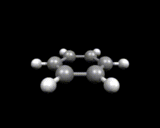Complicated Atoms
 |
Hydrogen is the simplest of atoms. How do more complex atoms differ? To answer this question we must consider more carefully the nature of the nucleus. We now know that the nucleus itself comprises smaller particles, protons and neutrons, whose mass is very similar. The protons each have a positive electrical charge, whereas the neutrons are uncharged. The proton charge is exactly equal to but opposite in sign to that of the electron, (a fact which surely hints at some underlying, more fundamental unity in nature). An atom is a neutral entity and must therefore have the same number of negatively charged electrons as there are protons in the nucleus. Different atoms are characterized by the numbers of protons in their nuclei; the nucleus of the hydrogen atom has one proton and hence traps one electron to yield the neutral atom; helium has two protons and hence two electrons; lithium three protons and three electrons. Uranium, the heaviest naturally occurring element, has a nucleus with 92 protons; heavier elements have been made during the last 60 years in nuclear reactors and particle accelerators.
Stable nuclei generally contain roughly equal numbers of protons and neutrons, although in the heavier nuclei the number of neutrons is generally greater. Conversely, there are several known nuclei with the same number of protons but with different numbers of neutrons. The resulting atoms will have different masses but the same number of electrons; their chemistry (which as we will see depends on the number of electrons) is therefore identical. They are known as isotopes of the same element.
Elementary electrostatics tells us that like charges repel. We might therefore expect the protons in the nucleus simply to fly apart. But the protons and neutrons (nucleons as they are collectively known) are held together by highly powerful attractive forces (known as strong interactions) which, however, operate over very small distances (just a few nucleon diameters). For this reason there is a limit to the number of protons in stable nuclei: as the charge builds up, the repulsive forces between the protons which extend over much larger distances begin to outweigh the attractive strong interaction. Unstable nuclei are radioactive. They may emit particles to achieve greater stability; for example, many heavy atoms emit α-particles (helium nuclei containing two protons and two neutrons) to reduce their total charge. Dramatic examples of nuclear instability are produced by the 'uranium-235' nucleus (which contains 92 protons and 143 neutrons - a total of 235 nucleons) which can split in two, the process of nuclear fission, which is accompanied by a very large release of energy.
To return, however, to the electrons which balance the charge of the nucleus. These we have seen can occupy 'standing wave' states (or orbitals) around the nucleus; and these states have different energies. We might expect that all the electrons would normally be present in the lowest energy orbital. Once more, however, the strangeness of the new physics confounds our expectations. For we find that for particles like electrons, it is impossible for exactly the same state to be occupied more than once - the famous exclusion principle first enunciated by Pauli (which reflects deeper aspects relating to the symmetries of wave functions of systems containing many particles). An additional twist is provided by the fact that electrons (and many other particles) have a property known as spin (which falls out naturally when relativity is included into quantum mechanics and which is manifested by the electron having a tiny magnetic moment). This can have two values which we can call 'up' and 'down'. So we can obey the Pauli principle with two (but no more then two) electrons in each orbital; for they are not exactly in the same state: one has 'up' and one has 'down' spin.
We balance the charge of our nucleus by 'feeding' the electrons in two by two into the orbitals - the standing wave solutions of the Schrödinger equation - starting with the lowest energy states. The resulting atom is a highly complex object; it is a cloud of electronic wave states interacting with each other but bound to the nucleus.
The account given here is of course the briefest of sketches of atomic structure; the interested reader will find further information here. It is, however, worth pausing at this point to reflect on the scale of the intellectual achievement represented by our current knowledge of the structure of atoms. As we recall, the modern atomic theory started with John Dalton's imaginative speculations stimulated by simple chemical observation. Within 130 years the strange, sophisticated but predictive model of atomic structure that we have outlined above had been developed. This remarkable success is a tribute to the creative power of the human mind when engaged in the cooperative search for the truth about the physical world that is the basis of science.
Finally, we will remember that the starting point for our discussion of atomic structure was the search for the ultimate constituents of matter. We have seen that atoms are not indivisible; they have substructure; moreover, that nuclei are made out of smaller particles - protons and neutrons. The immense efforts in high energy physics over the last fifty years have revealed large numbers of elementary particles in addition to protons, neutrons and electrons (although many of these have lifetimes that are unimaginably short). In addition, it is now clear that protons and neutrons have substructures and appear to be made out of even smaller particles, known as quarks. Whether quarks are indivisible or themselves have substructures only time (and a great deal of money) will tell.